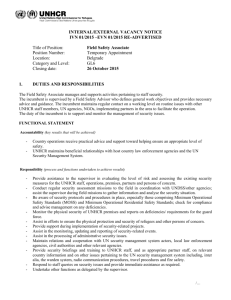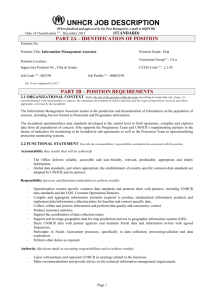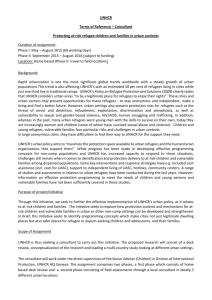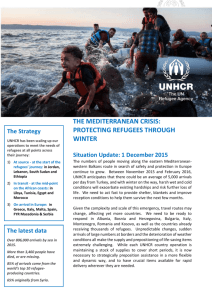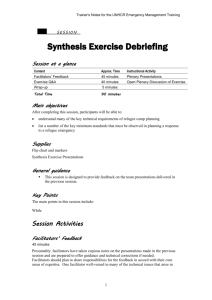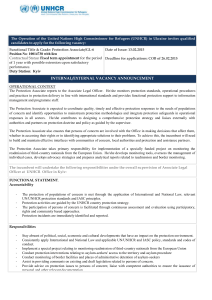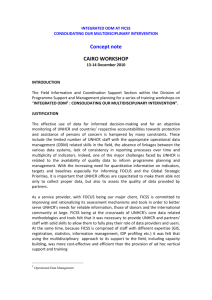Iraqi Situation Update
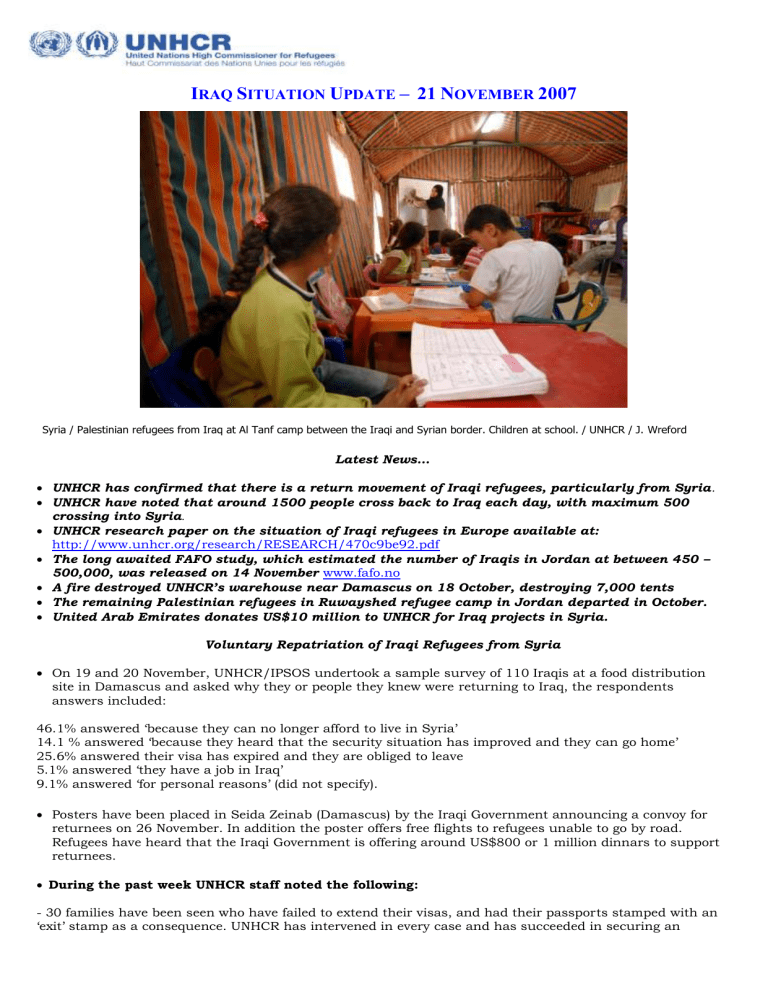
I
RAQ
S
ITUATION
U
PDATE
– 21 N
OVEMBER
2007
Syria / Palestinian refugees from Iraq at Al Tanf camp between the Iraqi and Syrian border. Children at school. / UNHCR / J. Wreford
Latest News…
UNHCR has confirmed that there is a return movement of Iraqi refugees, particularly from Syria.
UNHCR have noted that around 1500 people cross back to Iraq each day, with maximum 500 crossing into Syria
.
UNHCR research paper on the situation of Iraqi refugees in Europe available at: http://www.unhcr.org/research/RESEARCH/470c9be92.pdf
The long awaited FAFO study, which estimated the number of Iraqis in Jordan at between 450 –
500,000, was released on 14 November www.fafo.no
A fire destroyed UNHCR’s warehouse near Damascus on 18 October, destroying 7,000 tents
The remaining Palestinian refugees in Ruwayshed refugee camp in Jordan departed in October.
United Arab Emirates donates US$10 million to UNHCR for Iraq projects in Syria.
Voluntary Repatriation of Iraqi Refugees from Syria
On 19 and 20 November, UNHCR/IPSOS undertook a sample survey of 110 Iraqis at a food distribution site in Damascus and asked why they or people they knew were returning to Iraq, the respondents answers included:
46.1% answered ‘because they can no longer afford to live in Syria’
14.1 % answered ‘because they heard that the security situation has improved and they can go home’
25.6% answered their visa has expired and they are obliged to leave
5.1% answered ‘they have a job in Iraq’
9.1% answered ‘for personal reasons’ (did not specify).
Posters have been placed in Seida Zeinab (Damascus) by the Iraqi Government announcing a convoy for returnees on 26 November. In addition the poster offers free flights to refugees unable to go by road.
Refugees have heard that the Iraqi Government is offering around US$800 or 1 million dinnars to support returnees.
During the past week UNHCR staff noted the following:
- 30 families have been seen who have failed to extend their visas, and had their passports stamped with an
‘exit’ stamp as a consequence. UNHCR has intervened in every case and has succeeded in securing an
extension of the visa by 1-3 months. It is not widely known that a refugee can request legal support to attempt to secure an extension of their visa.
- refugees are rapidly running out of savings, and are not able to work. Many of the refugees planning to return to Iraq cite financial pressures as the driving reason
- Most refugees interviewed did not agree with the idea that security was improving throughout Iraq, noting that although some areas such as al Mansour, Sayida, Baghdad Amre and Kademe are seeing improved security, there are still occasional security incidents in these areas.
- refugees that have their children in school or who have a health problem are succeeding in renewing their visas
Internally Displaced Update – Iraq
The Iraqi Red Crescent reported 4 November that the number of IDPs rose to 2,299,425 by the end of
September 2007. This represented a 16 percent increase from the end of August (some 50,000+ per month). http://www.iraqredcrescent.org/IDP_27_update_EN.pdf
According to the latest figures received by UNHCR as of 12 November, it is estimated that over 2.2 million
Iraqis are displaced inside Iraq, with the following breakdown: 1,021,962 displaced prior to 2003; 190,146 displaced between 2003-2005 and 1,125,903 displaced after the first Samarra bombing in February 2006
(28,017 during October).
Internal displacement in northern Iraq increased with some 60 famililes fleeing shelling across the Turkey-
Iraq border in early November. Families who had fled earlier shelling on the Iranian –Iraqi border have returned to their homes. UNHCR is leading the inter-agency contingency planning should further military activity lead to additional displacement in northern Iraq.
Supply/Distribution of NFIs to refugees and IDPs inside Iraq
Until end October UNHCR had distributed the following NFIs to 15,394 families or 87,930 persons. tents
4,630
Blankets
70,872 mattresses
38,704 stoves
11,222 lanterns
8,359 liters diesel
10,340 jerry cans for water
17,522 plastic sheets
6,606 jerry cans for kerosene
8,825 kitchen sets
10,183 liters kerosene
95,315 hygiene kits
4,609 packs sanitary napkins pieces of clothes gas cylindres center poles for tents
8,602 1,382 17 105
Border Issues
Visa regulations for Iraqi nationals who wish to enter Syria have been modified at least 3 times since
February 2007. Finally, after Eid (17 October 2007), new visa regulations were announced according to which only 15 categories of persons are allowed to be granted visa for Syria and also to obtain a visa at the border.
The Jordanian Government has announced that they will introduce a visa regime for Iraqis. Until now, no such regime has been introduced. In practice, however, the Jordanian Government has already been quite restrictive in allowing Iraqis to enter Jordan.
Registration (UNHCR has now registerd over 210,000 Iraqis in the region)
Cumulative numbers
Est. Iraqi
Pop’n
Registered Cases Female PA
In
2007
Average
Case size
Syria
Jordan
Lebanon
Turkey
Egypt
Iran
GCC*
1.2 – 1.4 mil
500 – 750,000
50,000
5 – 10,000
20 – 40,000
57,000 +
200,000 +
134,689
50,753
9,239
4,276
10,132
3,673
1816
39,096
23,814
5,137
2,157
3,959
767
21.6%
26.5%
5.5%
21.3%
27.2%
9%
93,877
29,981
5,668
3,091
8,169
3,305
3.5
2
2
2
2.5
2.5
*Gulf Cooperation Council (Barhain, Kuwait, Oman, Qatar, Saudi Arabia and UAE).
Of the total registered
Syria
Jordan
Sunni s
52%
56%
Shiia
22.4%
26%
Christian s
17.6%
15%
Islam unspecified
2%
2%
Sabean-
Mandean
4.8%
1%
Yezidis
Lebanon
Turkey
Egypt
30%
35.9% n.a
57%
6.3% n.a
12%
18.8%
2%
0.7%
31%
98%
0.1%
0.9%
.0%
0.1%
From the known locations, originate from
Syria
Jordan
Lebanon
Baghdad
80%
70%
61%
Ninewa
5%
2%
5%
Diyala
5%
2%
5%
Basrah
3%
3%
3%
Egypt 93%
In Syria (end October)
Gender breakdown is 53% male, 47% female.
For those registered in 2007 only, the proportion changes to 63.2% Sunni, 17.5% Shiia, Christians 10.7%,
Sabean Mandean 3.8% and Yezidis 1.4%.
From those registered in 2007, over 35.9% have specific needs, including important medical condition
19%, child or adolescent at risk 4%, disabled 2%, older person 1%, woman at risk 2%.
Main locations in Damascus where Iraqis are accommodated include Saida Zainab and Garammana, while surrounding Damascus Iraqis are often found in Goudsaya, Masakin Barzeh and Saidnaya. Also governorates bordering Iraq such as Hassakeh and Deir al Zour as well as near the Jordanian border at
Sweda also host Iraqis.
In Jordan
Gender breakdown is 55% male, 45% female.
According to the FAFO’s figures the breakdown on religious affiliation is 60+% Sunni, 17-18% are Shiite; while the UNHCR’s figures are 56% Sunni and 26% Shiite.
From those registered in 2007, 14.5% have special needs although UNHCR believes this will continue to increase as outreach teams travel to areas outside of Amman and identify families who in many instances are afraid to approach the UNHCR office.
In Lebanon
Gender breakdown is 72% male, 28% female, with a much higher proportion of working age males.
In relation to Syria, Jordan, and Egypt, Lebanon is the only one to have more registered Shiite (50%) compared to Sunnis (30%).
22% of those registered with UNHCR have been identified as having special needs.
In Turkey
The ethnic breakdown includes 35.5% Arab, 35.9% are ethnic Turkmen, 18.1% Chaldean, Assyrian 3.4% and 4.9% Kurd.
Only 5.2% of the registered populations have special needs, which is a smaller proportion than in the other countries.
Large numbers of asylum seekers originate from Tameen, Ninewa and Baghdad.
In Egypt
Iraqi refugees registered with UNHCR in Egypt constitute 25% of the overall number of registered refugees and asylum-seekers in Egypt.
The number of Iraqis approaching UNHCR in Egypt for registration continues to decline and largely comprises Iraqis already in the country. Less than 500 Iraqis are scheduled for registration.
11% of the Iraqis registered by UNHCR are identified as having special needs, including some 8% (about
850 persons) with important medical needs.
Mobile Registration team in Syria
The first mobile registration exercise outside Damascus commensed on 7 October in El-Hol Camp,
Hassake Governorate. The original plan was to spend two months in El-Hol to complete the registration of an estimated 6000-7000 Iraqi refugees residing in Hassake and Qamishle Governorates.
The next location for the mobile registration is planned for Abu Kamal and Deir Zour in latter half of
November. Assessment mission for Deir Zour is planned for next week.
Al Tanf camp – No Mans Land Syria
UNHCR remains concerned about the number of Palestinians from Iraq that have been arrested and taken to Al Tanf by Syrian authorities recently. To date 97 have been taken to Al Tanf in the last two weeks, with a further 25 families expected in the next couple of days. There are currently 437 Palestinians in Al Tanf.
NFIs and food for increased numbers of Palestinians has been distributed. UNRWA has registered over
2500 Palestinians from Iraq in Damascus, most of whom entered with an Iraqi passport. UNHCR is travelling daily to the border to follow up on the needs of the new arrivals.
Palestinian refugees stranded at the Al Tanf refugee camp are suffering from the exposed location and a deterioration in the weather conditions including frequent sandstorms. As a consequence a number of the most vulnerable refugees are suffering from respiratory illnesses.
Al-Waleed camp, Syria UNHCR
Waiting Periods
In Jordan the waiting period has been reduced from 3 to 4 months to two to three days.
In Syria the waiting period for non-urgent interviews is approximately five months. The introduction of a visa requirement for Iraqis has resulted in renewed rush to register with UNHCR.
In Lebanon, it is 4 weeks.
In Egypt less than one month.
Possibly due to the long waiting period the no-show rate for interviews in Damascus remains relatively high at 47%.
Detention
In Lebanon, 584 Iraqis are in detention which is extremely high compared to other countries in the region.
The number of detained asylum-seekers and refugees increased by 9% from the previous month.
The majority of persons of concerns continue to be arrested for illegal entry/stay. At least 250 IRQ are detained beyond the end of their sentence (up to 1 year of arbitrary detention). Detention cases are continuously referred to pro-bono lawyers for legal representation.
In Jordan, UNHCR monitors 16 cases in detention. UNHCR intervened successfully on behalf of many
Iraqis, including a 67 year old woman, to secure their release.
In Egypt, the few detention cases involve asylum-seekers from Iraq arriving or attempting to depart at
Cairo International Airport without valid documents (including visas).
Resettlement Referral Update (as of 15 November)
Damascus
Iraqis
6,812
Cases/families
1,736
Target (20,000 for 2007)
90.82%
Amman 7,160 2,431 95.46%
Ankara 2,926 1,314 97.53%
Beirut 1,421 454 189.46%
Cairo 274 100 109%
Others 466 148 N/A
TOTAL 19,059 6,183 95.29%
Iran: 143 Iraqis (43families) have also been resettled.
Of this 13,782 have been referred to the US (4,525 cases/families) 1,625 to Australia, 1,361 to Canada,
922 to Sweden, 251 to Finland, 214 to the Netherlands, 213 to the UK, 241 to New Zealand, 108 to Brazil,
106 to Norway and 69 to Denmark, 16 to Ireland, 5 to Spain and 4 to France.
This represents over 95% of UNHCR’s 2007 target of 20,000 referrals. UNHCR offices have been averaging just over 500 referrals per week
.
Over 15% of referred cases are women at risk with another 13% being survivors of severe trauma
(including SGBV), detention, abduction or torture by various entities.
Departure
The trend in Jordan, Syria, Lebanon and Turkey has been to significantly higher departures, although the total number of departures for 2007 remains low, compared to referrals.
Jordan
Syria
Turkey
Lebanon
Tehran
Egypt
TOTAL
Av/ month Jan - July
33
66
22
10
11
August
162
202
293
77
10
September
388
3922
262
138
13
35
10
October
483
299
326
104
11
30
Total
1264
1225
997
258
136
42
The top countries accepting Iraqis are USA (2,015), Sweden (663), Canada (661) and Australia (418). The
Swedish example is particularly admirable because not only is it taking a very significant number of refugees compared to its population and quota, but all the refugees are referred by HCR, including some very vulnerable cases.
Palestinians and Non-Iraqi Refugees in Iraq
UNHCR believes that 12,000 to 13,000 Palestinians remain in Baghdad. Another 1,400 Palestinians are stranded in Al Waleed on the Iraqi side near the border with Syria; 474 in Al Tanf (in no man’s land between Iraq and Syria) – including 37 Palestinians who arrived on Friday 9 November; and 304 in El Hol which is located just inside Syria
In addition to the movement of 107 Iraqi Palestinians to Brazil UNHCR is also pursuing relocation options in Sudan, Yemen and Chile.
In addition to the Palestinians, UNHCR estimates that there are 11,736 Iranians (Kurds and Ahwazis),
15,593 Turkish citizens and over 2200 refugees of other nationalities. UNHCR offices in Northern Iraq have
reinforced stockpiles of non-food items and have developed contingency plans following the buildup of
Turkish forces on the border.
Education
Contributions and projections for the joint Education Appeal launched with UNICEF as of 26 October 2007 have reached USD 34,153,620 predominantly from the US.
The estimated enrolment of Iraqi refugee children is 70 000 in Syria. UNHCR has provided 15,655 school uniforms to Iraqi refugee children comprising the following: 6 091 for primary level, 7 404 for elementary level, 2 160 for secondary level. And 15,967 units of school stationary have been distributed comprising
6,117 for primary, 7,406 for elementary and 2,444 for secondary levels.
UNHCR has commenced construction of 6 schools in Damascus. Average construction time is 360 to 500 days.
In Jordan the number of Iraqi children enrolled is estimated at some 23,000 to 25,000.
In Egypt UNHCR has embarked on a campaign to increase the total number of Iraqi children enrolled in schools and assisted by UNHCR from the current 1,744 persons to an estimated 2,200 out of a total of
3430 registered Iraqi refugee children of school age.
Community Services
In Syria
The SGBV team has seen 13 cases during the reporting period. The majority of the cases are survivors of rape in Iraq and domestic violence. Recently, the Office is receiving several reports about Iraqi girls who have been sold and forced into prostitution as young as 12 years old. The SGBV team will be conducting home visits/ spot checks to find out more about these reports.
An arrangement for referring survivors of SGBV cases to psycho- social support has been made with a
National Center run by a well known psychologist. The referral will be on case by case basis after an initial assessment to be made by the SGBV focal point in protection.
According to the UNHCR database and based on the agreed criteria, the number of registered refugees entitled to receive food rations for November/December are 11,894 cases or 44,074 individuals. In addition there are 7,549 refugees outside Damascus who will be eligible, with a total of 51,674 persons. The target for 2008, subject to funding, will be to provide food assistance to at least 100,000 Iraqis.
6,780 families (over 17,900 individuals) have been identified for cash assistance. Based on a vulnerability assessment by UNHCR's community services staff, families will receive approximately US$100 per month.
The average cost of an apartment in Damascus is between USD 200 and USD 300/month.
Health
Some 180,000. Iraqis have accessed UNHCR supported SRCS medical facilities through 7 primary health centres. Of these 30% are referred to hospital and of these 15% require major assistance (surgery, longterm treatment). 50 Iraqi children received prosthesis.
Two new clinics dedicated to refugee healthcare opened on 25 Oct. in Damascus, in Sayyeda Zeinab and
Qudssaya.
The clinic in Sayyeda Zeinab is funded by the French Ministry of Foreign Affairs, the UNHCR, the French
Red Cross and the Syrian Arab Red Crescent (SARC). The plan is that by the end of 2007, this clinic will provide 4,500 Iraqi refugees with primary health care consultations and a further 370 Iraqis suffering from chronic diseases will be referred for more specialized care.
UNHCR opened the clinic in Qudssaya, another area of high concentration. This clinic will be administered by the Syrian Arab Red Crescent.
I
RAQ
S
UPPORT
U
NIT
C
ONTACT
:
Andrew Harper, Head of Iraq Support Unit
Email: Harper@unhcr.org · Telephone: (004122) 739 8105 ·
Mobile: + 41 79 599 92 36
